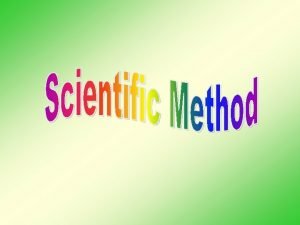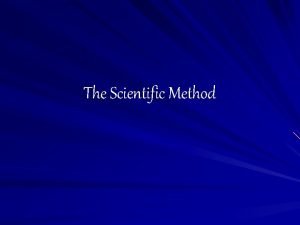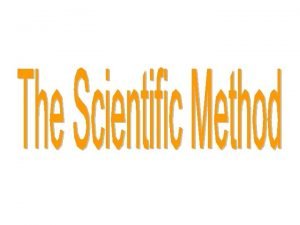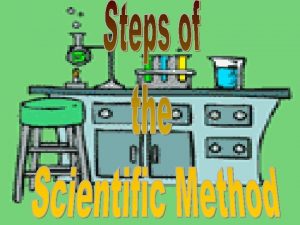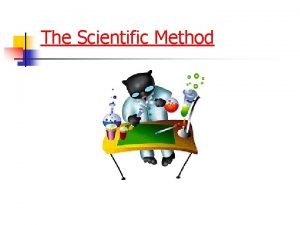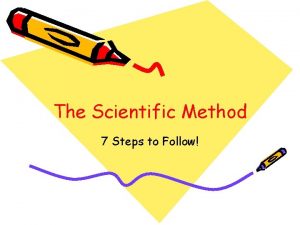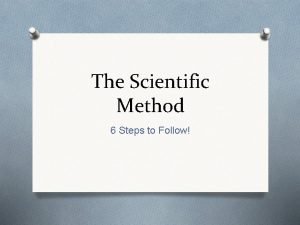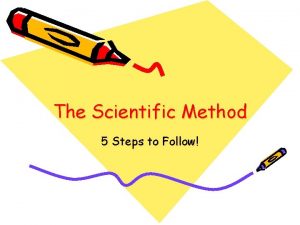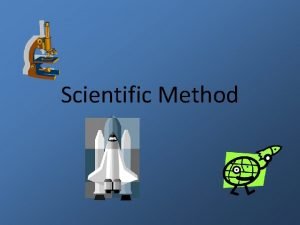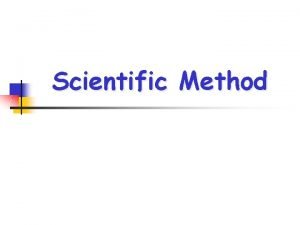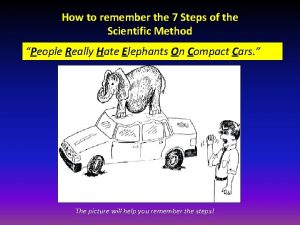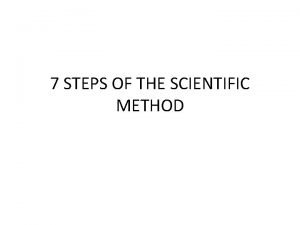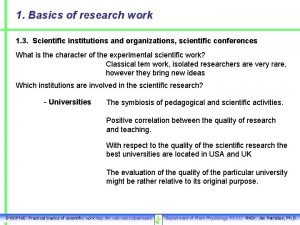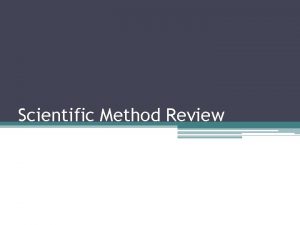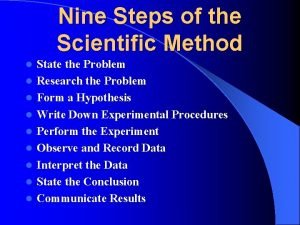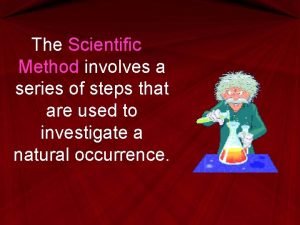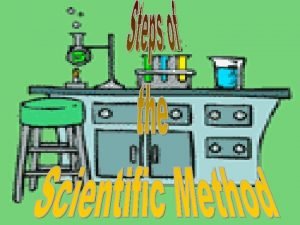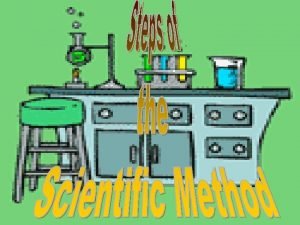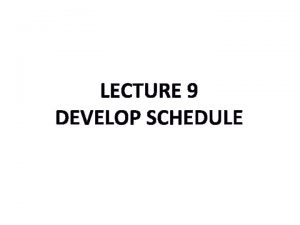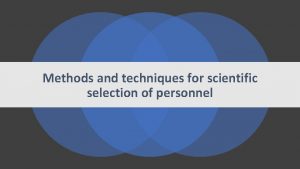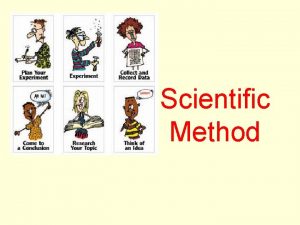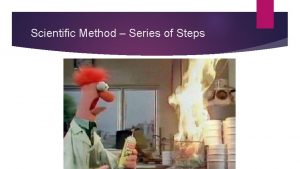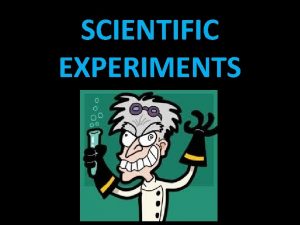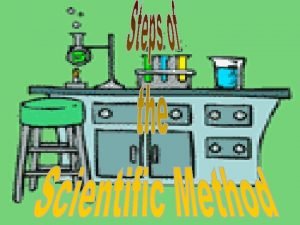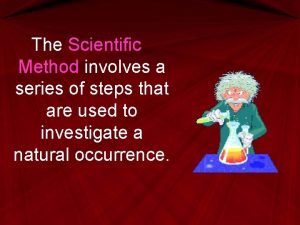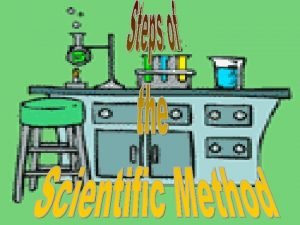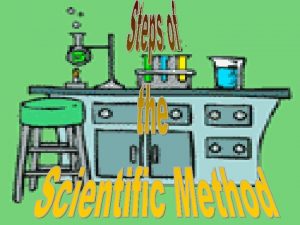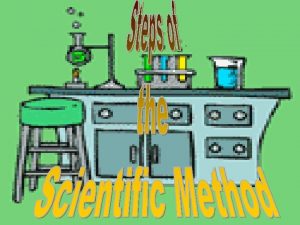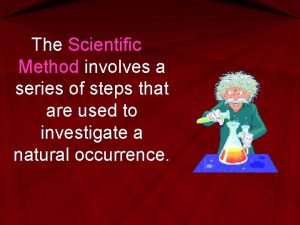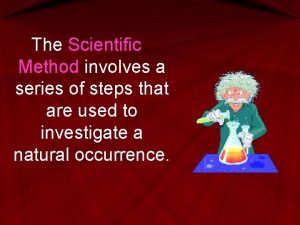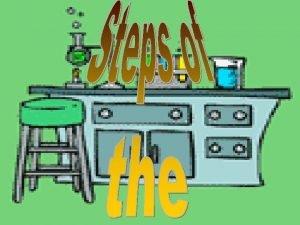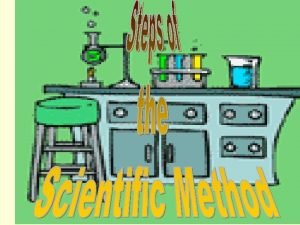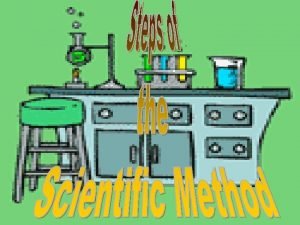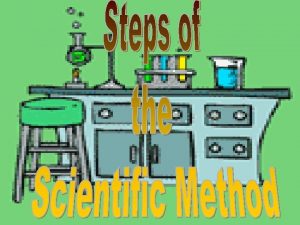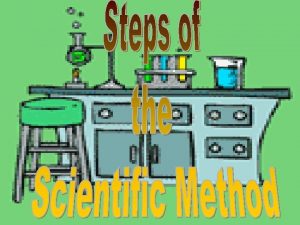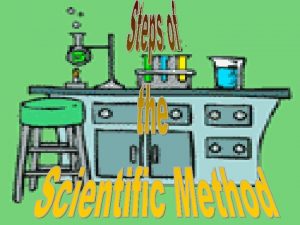The Scientific Method involves a series of steps




































- Slides: 36


The Scientific Method involves a series of steps that are used to investigate a natural occurrence.

Problem/Question Observation/Research Formulate a Hypothesis Experiment Collect and Analyze Results Conclusion Communicate the Results

Steps of the Scientific Method 1. Problem/Question: Problem/Question Develop a question or problem that can be solved through experimentation.

Steps of the Scientific Method 2. Observation/Research: Observation/Research Make observations and research your topic of interest.

Steps of the Scientific Method 3. Formulate a Hypothesis: Hypothesis Predict a possible answer to the problem or question. Example: If soil temperatures rise, then plant growth will increase.

Steps of the Scientific Method 4. Experiment: Experiment Develop and follow a procedure. The outcome must be measurable (quantifiable).

Steps of the Scientific Method 5. Collect and Analyze Results: Results Modify the procedure if needed. Confirm the results by retesting. Include tables, graphs, etc.

Steps of the Scientific Method 6. Conclusion: Conclusion Include a statement that accepts or rejects the hypothesis. Make recommendations for further study and possible improvements to the procedure.

Steps of the Scientific Method 7. Communicate the Results: so that others can confirm your results reliability-consistency

Let’s put our knowledge of the Scientific Method to a realistic example.

Problem/Question John watches his grandmother bake bread. He ask his grandmother what makes the bread rise. She explains that yeast releases a gas as it feeds on sugar.

Problem/Question John wonders if the amount of sugar used in the recipe will affect the size of the bread loaf?

Observation/Research John researches the areas of baking and fermentation and tries to come up with a way to test his question.


Formulate a Hypothesis After talking with others and conducting further research, he comes up with a hypothesis. “If more sugar is added, then the bread will rise higher. ”

Hypothesis The hypothesis is an educated guess about the relationship between the independent and dependent variables.

Independent Variable The independent, or manipulated variable, is a factor that’s intentionally varied by the experimenter. John is going to use 25 g. , 50 g. , 100 g. , 250 g. , 500 g. of sugar in his experiment.

Dependent Variable The dependent variable, is the factor that may change as a result of changes made in the independent variable. “The independent effects the dependent. ” In this case, it would be the size of the loaf of bread.

Experiment His teacher helps him come up with a procedure and list of needed materials. She discusses with John how to determine the control group.

Control Group In a scientific experiment, the control is the group that serves as the standard of comparison. Most often the control group is a “no treatment" group.

Control Group The control group is exposed to the same conditions as the experimental group, except for the variable being tested. All experiments should have a control group.

Control Group Because his grandmother always used 50 g. of sugar in her recipe, John is going to use that amount in his control group.

Constants John’s teacher reminds him to keep all other factors the same so that any observed changes in the bread can be attributed to the variation in the amount of sugar.

Constants The constants in an experiment are all the factors that the experimenter attempts to keep the same.

Constants They might include: Other ingredients to the bread recipe, oven used, rise time, brand of ingredients, cooking time, type of pan used, air temperature and humidity where the bread was rising, oven temperature, age of the yeast…

Experiment John writes out his procedure for his experiment along with a materials list in his journal.

Trials refer to replicate groups that are exposed to the same conditions in an experiment. John is going to test each sugar variable 3 times.

Collect and Analyze Results John comes up with a table he can use to record his data. John gets all his materials together and carries out his experiment.

Size of Baked Bread (Lx. Wx. H) cm 3 Size of Bread Loaf (cm 3) Trials Amt. of Sugar (g. ) 1 2 3 Average Size (cm 3) 25 768 744 761 758 50 1296 1188 1296 1260 100 1188 1080 1116 250 672 576 588 612 500 432 504 360 432 Control group

Collect and Analyze Results John examines his data and notices that his control worked the best in this experiment, but not significantly better than 100 g. of sugar.

Conclusion John rejects his hypothesis, but decides to re-test using sugar amounts between 50 g. and 100 g.

Experiment Once again, John gathers his materials and carries out his experiment. Here are the results.

Size of Baked Bread (Lx. Wx. H) cm 3 Size of Bread Loaf (cm 3) Trials Amt. of Sugar (g. ) 1 2 3 Average Size (cm 3) 50 1296 1440 1296 1344 60 1404 1296 1440 1380 70 1638 1560 1612 80 1404 1296 1332 90 1080 1200 972 1084 Control group

Conclusion John finds that 70 g. of sugar produces the largest loaf. His hypothesis is accepted.

Communicate the Results John tells his grandmother about his findings and prepares to present his project in Science class.
 Involves a series of steps
Involves a series of steps Scientific method involves
Scientific method involves The first step in the scientific method involves
The first step in the scientific method involves The scientific method involves
The scientific method involves Scientific inquiry vs scientific method
Scientific inquiry vs scientific method 7 steps of the scientific method
7 steps of the scientific method 7 steps of the scientific method
7 steps of the scientific method Scientific method seven steps
Scientific method seven steps What are the 6 steps of the scientific method
What are the 6 steps of the scientific method 5 steps to scientific method
5 steps to scientific method Steps of scientific method
Steps of scientific method Scientific method steps
Scientific method steps Scientific method 5 steps
Scientific method 5 steps People really hate elephants on compact cars
People really hate elephants on compact cars 7 steps to scientific method
7 steps to scientific method Steps of scientific method
Steps of scientific method Six steps to the scientific method
Six steps to the scientific method What are the nine steps of the scientific method
What are the nine steps of the scientific method What are the steps to the scientific method? *
What are the steps to the scientific method? * Scientific method steps
Scientific method steps Scientific method steps
Scientific method steps Scientific method steps
Scientific method steps A good fraud auditing involves four steps
A good fraud auditing involves four steps How is a scientific law different from a scientific theory?
How is a scientific law different from a scientific theory? Separation
Separation The fast tracking method of schedule compression involves
The fast tracking method of schedule compression involves What is the conclusion in the scientific method
What is the conclusion in the scientific method Scientific selection process
Scientific selection process Maclaurin series vs taylor series
Maclaurin series vs taylor series Heisenberg 1925 paper
Heisenberg 1925 paper Taylor vs maclaurin
Taylor vs maclaurin Maclaurin series vs taylor series
Maclaurin series vs taylor series Ibm p series server
Ibm p series server Shunt-series feedback amplifier
Shunt-series feedback amplifier Series aiding and series opposing
Series aiding and series opposing Sum of infinite series formula
Sum of infinite series formula Symposium is a type of which method
Symposium is a type of which method
